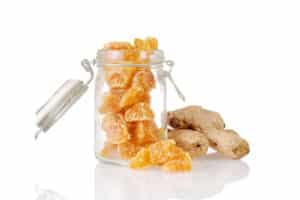Ginger Herb Profile
Ginger is also known as Zingiberus rhizoma and snake root (Canada snakeroot/Virginia snakeroot). It is a popular ancient remedy for digestion that is still widely used today.
What is Ginger?
COMPOSITION
Ginger root refers to the peeled fresh or dried root of the ginger plant. Ginger root contains essential oil.
DESCRIPTION AND HISTORY
Ginger graces ancient medical texts from China, India, Greece and Rome. The traditional use as a colic, morning sickness and digestion remedy remains the most common use to day. Germany’s Commission E suggests it for motion sickness and gastric upsets and the British Herbal Compendium adds morning sickness to the list. All of these uses are widely supported by the literature.
What Does Ginger Do?
DIGESTIVE COMPLAINTS
Ginger has been evaluated in multiple clinical trails for nausea from a wide variety of sources ranging from chemotherapy to pregnancy. It is effective on an as-needed basis with a daily dose of 1-2g total. In the literature, studies evaluating ginger’s efficacy at treating nausea have found it to be effective for nausea caused by: morning sickness, motion sickness, chemotherapy, medication side effects, and surgical procedures. Ginger is well known for its ability to boost gut health, and recent research has evaluated its ability to alleviate anxiety as a result. When taken regularly, it appears to help prevent and treat moderate anxiety.
ANTI-FUNGAL
Ginger is a potent anti-fungal which is safe to take liberally in the diet as well as topically in a balm or salve. Both the essential oil and the whole herb have shown anti-fungal actions (Singh, et al, 2008). The crude herb can be ingested throughout the infection and the oil or an infusion of the herb can be applied topically. Because the active components are lipid-soluble, water based infusions are typically insufficient.
EXCESSIVE MENSTRUAL BLEEDING
Ginger taken as a supplement can benefit health in many ways, but an overlooked and, for many women, exciting benefit is the relief of excessive menstrual bleeding. A 2015 study gave teen girls a ginger capsule or placebo daily over the course of 6 months. During 3 of the months, the girls were objectively monitored for changes to blood flow. The ginger group saw significant reductions in overall blood loss during their periods. (Kashefi et al, 2015)
EXERCISE PAIN
After strenuous exercise, the body undergoes significant recovery efforts, leaving you feeling inflamed, stiff, and sore. In a 2010 study, ginger supplementation for 11 days using two different ginger treatments–heated or cooked ginger and raw ginger–measured pain and inflammation after strenuous exercise. (Black et al, 2010) Both types resulted in significant reductions in these unpleasant effects, making ginger an important component of the diet or supplement routine when vigorous exercise is common.
How Do I Use Ginger?
PREPARATIONS
Ginger is best consumed in culinary-type preparations where the whole herb or its infusions are ingested. This includes syrups, chews, extracts, and EO based preparations. Ginger’s active components, gingerols, are too heavy to be extracted in essential oils, but are lipid-soluble, so preparations which focus on extracting lipids are ideal.
DOSE
The dose for an otherwise healthy adult is 1-2g/day, with 1g servings administered prior to an operation for maximum efficacy.
REFERENCES
Black, C. D., Herring, M. P., Hurley, D. J., & O’Connor, P. J. (2010). Ginger (Zingiber officinale) reduces muscle pain caused by eccentric exercise.The Journal of Pain, 11(9), 894-903.
Kashefi, F., Khajehei, M., Alavinia, M., Golmakani, E., & Asili, J. (2015). Effect of Ginger (Zingiber of ficinale) on Heavy Menstrual Bleeding: A Placebo‐Controlled, Randomized Clinical Trial. Phytotherapy Research, 29(1), 114-119.

